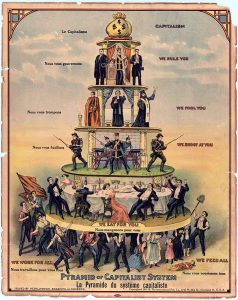Skip to main content

table of contents
Notes on Kropotkin
Biography
- Descendent from an ancient line of Russian princes
- Influenced by liberal ideas, became a Cossack (noble cavalrymen) and moved to Siberia. Was horrified by the penal system
- 1865: Read anarchist Joseph Proudhon’s work
- 1866: Resigned from Cossacks in protest over the execution of prisoners
- 1871: Devoted himself to science, Russian Geographical Society.
- 1872: Reads Bakunin, meets with Russian exiles, declares himself an anarchist
- 1874: Arrested by the Tsar, but escapes two years later
- 1876- 1886: Founded a newspaper, was arrested in France, exiled to London
- In London he starts writing his most important books
Critique of the Soviet Union
- 1917: Returns to Russia after the Tsar is deposed. He arrives before the Bolshevik Revolution
- Retires to write.
- In 1920, he writes a letter to Lenin, advising him against taking the route of violence and authoritarianism. https://theanarchistlibrary.org/library/petr-kropotkin-letter-to-lenin
- 1921: Kropotkin’s funeral was a large anti-Bolshevik demonstration
“Everywhere you will find that the wealth of the wealthy springs from the poverty of the poor.” – Kropotkin
“Pyramid of the Capitalist System” critiques capitalism, namely the wealth disparity and exploitation of labor.
Anarcho- Communism: Kropotkin Style
- Mutual Aid rather than competition (based on observations of the “natural” world)
- Human beings are naturally sociable, government is unnecessary
- The abolition of private property dissolves inequality of income and gives place to the free distribution of goods and services, rather than trying to determine individual contributions.
- In Anarcho-Communist communities, workers have access to goods and services to cover their needs through a “free distribution warehouse”
- Socially necessary labor is the time that it takes people in general to make something. It cannot be commodified (converted into $)
- Cooperation is the motor that moves humanity
- Kropotkin advocated for small communities that controlled the means of production (land, machines, tools) in a collective warehouse
Differences with Liberals
- The state is not a place for the common good, it is an institution that protects private property and those that hold it
- The “social contract” does not protect the poor. The poor were not invited to sign it. They were forced by poverty
- Against wage labor. In support of worker control of the means of production
- Against Laissez-faire capitalism
Differences with Marx
- Kropotkin thought that humankind was, by nature, into cooperation and mutual support. In contrast, Marx thinks that all of us are the product of our times, circumstances, and most importantly, how we go about producing and reproducing our lives.
- Marx believed that humanity progressed through stages, the same stages that the European tribes had gone through. This progress was the result of class struggle. He focuses on the constant fight between the bourgeois and the proletariat over the appropriation of surplus value. Kropotkin thought that humanity resembled the world of the insects, where ants, for example, cooperate with each other in support of their communities. He believed it was a cooperation among the workers that moved the world forward, not class struggle.
- As a tradition toward a fully communist society, Marx believed that there could be some stratification in the first stages of the new world. Both in the Soviet Union and Cuba, for example, workers received salaries, which were not all the same. In contrast, Kropotkin claims that everybody who works should be able to have all of their needs and desires fulfilled by a warehouse, an institution that holds all the wealth of the community and distribute it according to needs. The Zapatistas in Chiapas are organized around Kropotkin’s model of the warehouse.
- While Marx is only interested in expropriating private property, Kropotkin believes everybody should be equal in communist societies, otherwise, it is hard for everybody to sacrifice and pull together. Everything there is belongs to a communal warehouse. Marx, on the other hand, emphasized private property expropriation over expropriation of personal possessions because he was interested in the workers being able to control the wealth they produced and could not enjoy. He points out that the wealth produced by the worker is often, through politics dominated by private contributions, used against the workers themselves.
- For Marx, progress was closely linked with domination of nature (technology, machines), as it was for the bourgeois that he so much criticized and reluctantly admired. We don’t see that in Kropotkin. Marx’s conception of progress, linked with domination of nature, has been criticized as ecologically blind. In general, anarchists, even contemporary ones, privilege nature and communities over industry and profit.
- Marx sought a new human, while Kropotkin sought to establish social relations that would liberate the human we already are. Marx maintained that the workers would have to create a state to control the newly dispossessed bourgeois, while Kropotkin thought we should create communities free of capitalism.
- Marxism, in general, advocates for the take over of the bourgeois state, the liberal democracies of the western world. Kropotkin style anarchists, on the other hand, advocate for federations of small communities with control of government from below by frequent rotation. We will see a living, highly successful example of this style of governance when we study the indigenous Mayan communities that organize with the Zapatistas, in Chapter 10.
Part Four Video Lecture
Media Attributions
- Peter Kropotkin © Koroesu
- Pyramid of Capitalist System (1911) © Nedeljkovich, Brashich, and Kuharich is licensed under a Public Domain license